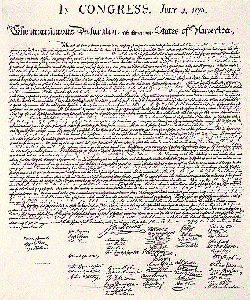|
  |
| The Declaration of Independence |
|
 |
 |
A historical document examined.
from the fountain pen of
Len Provisor |
|
 |
 |
 |

The officially signed Declaration of Independence was engrossed
upon parchment by order of the Continental Congress. The single
sheet which contains this text was signed on July 4, 1776
and by most of the members during the following few months.
Unfortunately Congressional records do not give the name of
the person from whom the parchment was purchased.

From present indications this document was originally kept
rolled, as there are no creases that would suggest it had
been folded. Previous to 1841 the parchment had been carelessly
rolled and unrolled so many times that the writing ink of
the heavy engrossing at the top had become cracked and the
text and signatures damaged to such an extent that at the
present time the fine lines of the document are barely discernable.
I recently viewed this historical artifact in Washington,
D.C., kept in a inert gas chamber under dim lighting, it was
difficult to read, but my impression of this American document
was profound.
The original Declaration was adopted on July 4, 1776, and on the same day the Continental Congress directed that copies be printed for distribution to official bodies in various states and to the Continental Army. These broadsides were made by John Dunlap, official printer to the Congress, on the evening of July 4 and the morning of July 5th. The paper maker's watermark
Is "J. Honig & Zoonen" well-known Dutch papermakers of Zaandyk, Holland. There are only a few copies of this priceless broadside known to exist. A few years ago, at an antique flea market near Boston, a man purchased an old frame for $5.00. Upon examining the backing he found one of these broadsides, folded behind cardboard. It was recently sold at auction for well over $ 1 million, and considered to be the finest example in existence.
The paper used by Thomas Jefferson in writing the "First Ideas" of the Virginia Constitution in 1776 measures 7 ¾" x 12 ¾" and is watermarked "L G V" This paper is of Dutch origin and was made by one of three prominent papermakers of the period: Lubertus van Gerrevink of Egmond a/d Hoef, North Holland Lucas van Gerrevink of Alkmaar, or L. van Groot (or Grooten).
Thomas Jefferson's "Rough Draft" of the Declaration of Independence is written on four pages of Dutch paper, each measuring 7 7/8" x 12 3/8". This document was written on "WRYHEYT " paper which bears the watermark lettering 'PRO PATRIA EIUSQUE LIBERTATE" in an oval border surrounding a lion, capped by a crown. This watermark was commonly used by Dutch papermakers and may have been from one of a dozen different paper mills.
The earliest attempts in the making of reproductions of the Declaration of Independence were by Benjamin Owen Tyler in April, 1818 and John Binns, both working on facsimile versions since 1816, resulting in a heated controversy as to proprietary rights. Tyler published an pamphlet in which he stated the paper used for his facsimile was made by Gilpin, a Pennsylvania papermaker. According to Tyler the paper was "worth $200. a ream and will be superior to any paper in this or any other country." A description of the paper used by Binns was given in the Democratic Press, April 30, 1817, and reads: "We have this day received from the paper mill of Mr. Thos. Amies (Lower Merton, Montgomery County, PA) the paper on which we intend to print the splendid edition of the Declaration of Independence, which for fourteen months last past, has been under the graver. The paper is believed to be of a size and quality superior to any ever manufactured in the United States. The moulds and felts used in this process were of the best kind, and manufactured for this purpose. The paper weighs one hundred and forty pounds, and the price is $125. per ream. Cotton rags were altogether excluded, using only the finest linen.
Vintage hand-made papers are a fascinating pursuit of mine, especially exciting when finding watermarks and tracing the origins. A recent purchase of a common 1807 Land Deed from Potter County, Commonwealth of Pennsylvania has me greatly excited, because the name of the notary official is Matlack, M.A. I am almost certain that this is the one and the same Mr. Matlack who thirty-one years prior was directed by the Continental Congress to hand letter the parchment of the Declaration of Independence for signature on July 4, 1776.
|
|
 |
 |
|


